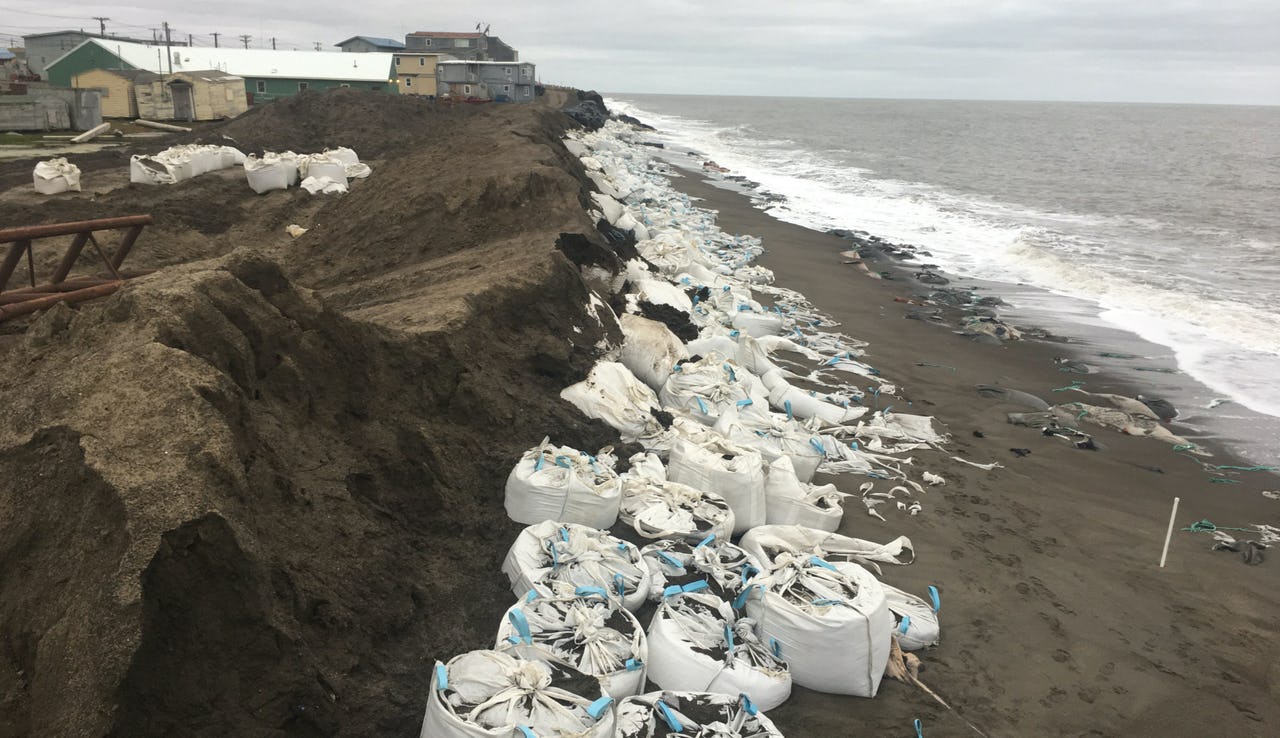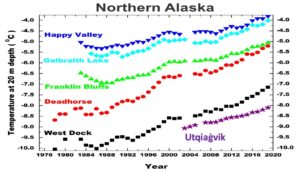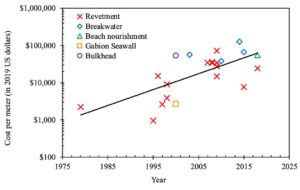Infrastructure and Community Resilience in the Changing Arctic: Status, Challenges, and Research Needs

Temporary coastal erosion control using supersacks in Utqiaġvik, Alaska, August 28, 2019. Photo: Louise Farquharson
Permafrost thaw is one of the world’s most pressing climate problems, already disrupting lifestyles, livelihoods, economies, and ecosystems in the north, and threatening to spill beyond the boundaries of the Arctic as our planet continues to warm. To examine the effects of permafrost degradation, and increase our understanding of what this phenomenon means for the future of the region (and the world), The Arctic Institute’s new two-part permafrost series aims to analyze the topic from scientific, security, legal, and personal perspectives. The second installment of our series features eight new articles on permafrost degradation and its effects on Arctic life, research, and the world at large. But before, check out the seven articles from our first installment, starting with the Intro.
The Arctic Institute Permafrost Series 2021
- Agents and the Arctic: The Case for Increased Use of Agent-Based Modeling to Study Permafrost
- Drunken Forests: Teaching About Permafrost Thaw Through Personal Experience
- The Global Carbon Budget and Permafrost Feedback Loops in the Arctic
- Meltdown – The Permafrost that Holds the Arctic Together is Falling Apart
- Reducing Individual Costs of Permafrost Thaw Damage in Canada’s Arctic
- North but Maybe Not North Enough: Adapting Sub-Arctic Communities and Infrastructure to a Changing Climate
- Climate Change and Geopolitics: Monitoring of a Thawing Permafrost
- Infrastructure and Community Resilience in the Changing Arctic: Status, Challenges, and Research Needs
- Permafrost Thaw in the Warming Arctic: Final Remarks
The Arctic is currently experiencing rapid widespread environmental upheaval driven by climate change that is unprecedented on a millennial timescale. Thawing permafrost and accelerated coastal dynamics are disrupting existing natural and built environments and threatening communities, industries, and cultures in circumpolar countries. Such rapid change also affects our ability to defend and secure the Arctic and its Peoples. Permafrost, ground material that remains at or below 0°C for at least two consecutive years, is a critical component of the cryosphere and the Arctic system. Now, permafrost is warming at increasing rates. Figure 1 shows the rapid warming trends measured in permafrost at six Northern Alaska locations over the past four decades. Widespread degradation of permafrost has already caused significant damage to infrastructure throughout the Arctic, creating a diverse and widespread engineering challenge.
Another engineering challenge, one that will require a multidisciplinary approach, is that of permafrost coastal erosion. Permafrost coasts make up 34 percent of the world’s coastlines. In the past 50 years, Arctic coastal erosion has been accelerating, in part due to permafrost thaw.1) Over the period of 1950 to 2000, the mean Arctic-wide permafrost-affected coastal erosion rate was 0.5 meters/year (m/yr) while the permafrost coasts along the US and Canadian Beaufort Sea experienced higher erosion rates of 1.1 m/yr.2) Erosion along ocean shores and riverbanks not only threatens communities located there but also national infrastructure designed to serve a broad set of users both in circumpolar regions and throughout the world.3) As an example, more than 85 percent of Alaska Native villages are impacted by coastal erosion and flooding 4) because they were constructed in dynamic coastal environments. Relocating these villages, due to accelerated erosion from events such as intense storms,5) is expected to cost tens of billions of dollars. Infrastructure damage due to permafrost degradation and coastal erosion also impacts the operations of industries that rely on natural resource extraction, security and humanitarian assistance agencies, and the defense enterprises of arctic nations. Collectively, the threat of permafrost thaw and coastal erosion can destabilize the nation’s security, economy, and well-being.

Degradation and erosion of permafrost have induced substantial damage to coastal infrastructure and facilities across the Arctic, including Alaska. For example, in 2004 and 2005, several consecutive large storms (30-year events) eroded the shoreline of Kivalina, threatening both the school and the Alaska Village Electric Cooperative’s tank farm and eventually forcing the community to plan for relocation.6) In 2016, erosion along the permafrost-affected banks of the Kokolik River in Point Lay resulted in the drainage of the community’s main freshwater source.7) In September 2017, Utqiaġvik was hit by an Arctic storm, which caused over $6 million in damage to public structures and was declared a federal disaster.8) Figure 2 shows a temporary coastal erosion control measure using large sandbags (supersacks), which were being destroyed by the storm. Permafrost thaw reduces the bearing capacity of piles and footings for civil infrastructure such as residences, public buildings, and elevated utility lines. Even when the ground temperature rises to –1° or –2° C without permafrost thawing, failures may occur due to the reduced shear strength of soil.9) Uneven surfaces created by differential thaw settlement can affect the functionality and serviceability of aboveground power lines and pipe systems for water, sewage, and fuel. Permafrost degradation is projected to raise the maintenance cost of the public infrastructures in Alaska by U.S. $3.6–6.1 billion by 2030 and another U.S. $5.6–7.6 billion by 2080.10) The costs of permafrost thaw are borne on individual families as well as the society at large.11) A recent synthesis of the prevention and control measures for coastal erosion in northern high-latitude communities showed the cost of coastal erosion control measures has continued to increase in the past four decades.12)

As with many other societies on Earth, Arctic peoples have a history of being able to adapt to diverse and challenging environments. Adaptation and resilience in extreme environmental challenges are part of their culture; but when rates of changes are accelerated adaptation becomes much more difficult.13) Arctic peoples face the added threats of warming and thawing of permafrost, a trajectory that will continue to affect almost all aspects of lives in the Arctic communities. Mitigating the effects of thawing permafrost diverts resources away from other critical needs, affects social networks, and changes subsistence practices, which are already modified due to globalization. Beyond the effects on infrastructure, culturally important aspects of heritage sites (e.g., burial grounds, sacred landforms, and iconic flora and fauna) as well as more pragmatic structures such as ice cellars, are under threat of loss.14) Location-based cultural heritage is critical to sustaining cultures in a rapidly changing world.15) When such heritage is lost it puts a strain on the very elements of resilience that have served indigenous communities well for more than a millennium.16)
Challenges and Research Needs in Understanding and Addressing the Complex and Interdependent Processes and Impacts
Predicting how permafrost coastlines will change in the coming decades is complicated by the high variability of this system already is at present — even without the influence of climate change. Forcing mechanisms, such as wave regime and sediment supply, act across many different temporal and spatial scales while sea ice, Arctic Ocean storms, tides, and constantly changing wave regimes interact with and influence ice-rich bluffs, deltas, lagoons, and barrier islands. This creates a dynamic system with a diverse and constantly varying morphology. Further complicating the issue is the fact that Arctic coasts represent a key intersection between natural and built environments and social systems that are changing rapidly due to climate and land use changes at local to global scales.17) Although coastal erosion in permafrost regions of the Arctic has been documented for decades,18) its social and ecological impacts have only recently been amplified and increasingly recognized due to the accelerating recession of shoreline.19) Recent observations suggest that the factors driving increasing rates of coastal change are complex and involve many nonlinearities.20) As such, understanding how ongoing climate change may influence this dynamic system is a significant challenge as permafrost warming and thawing, changes in ocean temperature, ecological feedback, financial factors, and social factors all interact over different spatial–temporal scales.
Across the Arctic, policymakers, planners, and infrastructure developers currently rely on data that are outdated, sparse, and do not include state-of-the-art knowledge. To date, pan-Arctic geohazard mapping has only been conducted at a relatively coarse spatial resolution of 1 km 21) and there is an urgent need for mapping at high spatial resolution (to support engineering design) as well as an assessment of how changes in circumpolar permafrost conditions could affect infrastructure.22) Owing to the increasing economic and environmental relevance of the Arctic,23) it is important to gain detailed knowledge about risk exposure in areas of current and future infrastructure.24) A decision support tool that leverages advanced analytics coupled with local and place-based knowledge, from a diverse set of stakeholders, is needed to provide defense, industry, and community engineers and planners with guidance for infrastructure adaptation and design in the dynamic Arctic environment.25)
To achieve infrastructure and community resilience, convergent research is needed to understand the complex interrelationships and mutual impacts of continued climate change in the Arctic among the following components: permafrost degradation and coastal erosion, civil infrastructure and development, and community well-being and sociodemographic and cultural resilience. There are five barriers of developing solid knowledge base for convergent research, including: (1) lack of understanding of the interdependent and complex processes of climate change, permafrost degradation, soil-infrastructure and human-infrastructure interactions; (2) uncertainties and quantification of climate change and system responses; (3) heterogeneity of ground materials; (4) lack of in-situ and long-term data to fully understand these complex system responses particularly at the decadal sale and in extreme environments; (5) fully engaging the entire span of communities who have local and place-based knowledge, including millennia of practicing adaptation and resilience.
A Current Research Effort to Advance Understanding of Infrastructure and Community Resilience in the Changing Arctic
IIn order to understand the complex interrelationships and mutual impacts of continued climate change in the Arctic, a convergent research team is formed by the authors and supported by National Science Foundation’s Navigating the New Arctic (NNA) program and Accelerating Research through International Network-to-Network Collaborations (AccelNet) program. Four specific research questions will be addressed by the NNA project. (1) What is the rate and magnitude of permafrost degradation and the associated land loss in the Arctic Alaskan coastal region and what are the key mechanisms driving these processes? (2) How will permafrost degradation and the associated land loss affect infrastructure presently and in the future? (3) What are the anthropological and cultural impacts of permafrost coastal erosion and permafrost degradation on coastal communities? (4) What are the quantitative impacts of permafrost degradation, coastal erosion, and infrastructure disruptions on sociodemographic resilience? (5) How should Arctic coastal communities adapt to future and continued climate change, permafrost degradation and coastal erosion?
The 5-year research project will yield the following intellectual products.
- A thermal model with high-spatial resolution (30 m) to evaluate and predict the rate, extent, and mechanisms of permafrost degradation in the next century for the Alaska North Slope Borough (NSB) and the maximum entropy principle model (MaxEnt, a machine learning algorithm) to estimate the future rate of bluff erosion and thermokarst development for four study sites in NSB.
- An infrastructure hazard map and model of the Alaska NSB under the effects of permafrost degradation and coastal erosion over the next century. The hazard map will provide dynamic downscaling of data and projections that represent current and future Arctic conditions. The model will integrate climate and environmental variables into engineering design parameters for load-bearing capacity and time-dependent settlement and will have web-based interactive visualization capabilities.
- Knowledge co-produced with Arctic indigenous communities on the most urgent issues relating to permafrost degradation and coastal erosion and flooding, as well as observations of these phenomena over an extended period of time. This knowledge will be used to inform the modeling efforts and will be summarized in the form of reports to be publicly available to the communities.
- A quantitative assessment model of sociodemographic resilience of Arctic communities to permafrost degradation and coastal land loss. Such a model will allow a range of users to have greater confidence that investments made ahead of permafrost degradation will minimize negative trade-offs in terms of economics and community well-being and health.
- A holistic predictive model that informs the adaptation of local civil infrastructure and the sociodemographic and cultural resilience of Arctic communities under ongoing permafrost degradation and coastal erosion. The ultimate goal of this holistic model is to advance Arctic prosperity and security locally, regionally, and globally.26) This allows us to forecast the adaptations necessary for civil infrastructure to sustain and for social systems to prosper under future and continued climate change and permafrost degradation. The model will also provide transformative knowledge and tools for policymakers and decision-makers to assess the effectiveness, and trade-offs, of potential technological advancements.
Our work is critical to inform future investments toward adaptations of social systems and the built environment to the rapid changes currently occurring in the Arctic. Findings from this research will inform science-based decisions and policymaking in response to ongoing environmental changes. Such informed decision-making will advance economic prosperity, promote human health, and preserve the security of the United States and the entire Arctic region.
Summary and Conclusions
A warming Arctic is driving rapid changes in both the natural and built environments; it is challenging the resilience of social and cultural systems and it is demonstrating that a resilient Arctic is a resilient world. Our work is ensuring that we can foresee the consequences of these threats and the economic, social and security consequences and provide guidance for mitigation and adaptation. The effort undertaken by the authors to advance understanding of infrastructure and community resilience in the changing Arctic is one of the first of its kind and draws on the diverse skillsets of not only the scientists but also the broad range of collaborating communities, partners, and knowledge holders. Data from this effort will inform intergovernmental and international collaboration and identify the types of investments needed to develop innovative engineering solutions, with the goal to achieve resilient infrastructure and communities in a rapidly changing Arctic.
Acknowledgement
This work is supported by the National Science Foundation under grants ICER-1927718, ICER-1927708, ICER-1927713, ICER-1927715, OISE-1927137, and OISE-1927553. Any recommendations or conclusions are those of the authors and do not necessarily reflect the views of the US Government.
Ming Xiao co-authored the article with Lilian Alessa, Louise M. Farquharson, Dmitry Nicolsky, Benjamin M. Jones, Vladimir E. Romanovsky, Anne Jensen, Christopher McComb, Xiong Zhang, Min Liew and Xiaohang Ji.
References